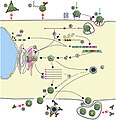File:Fcimb-09-00283-g002.jpg
Jump to navigation
Jump to search

Size of this preview: 578 × 600 pixels. Other resolutions: 231 × 240 pixels | 462 × 480 pixels | 765 × 794 pixels.
Original file (765 × 794 pixels, file size: 381 KB, MIME type: image/jpeg)
File history
Click on a date/time to view the file as it appeared at that time.
| Date/Time | Thumbnail | Dimensions | User | Comment | |
|---|---|---|---|---|---|
| current | 02:20, 13 June 2020 |  | 765 × 794 (381 KB) | commons>Guest2625 | Uploaded a work by Javier Orlando Cifuente and Gonzalo Moratorio from https://www.frontiersin.org/articles/10.3389/fcimb.2019.00283/full with UploadWizard |
File usage
The following page uses this file: